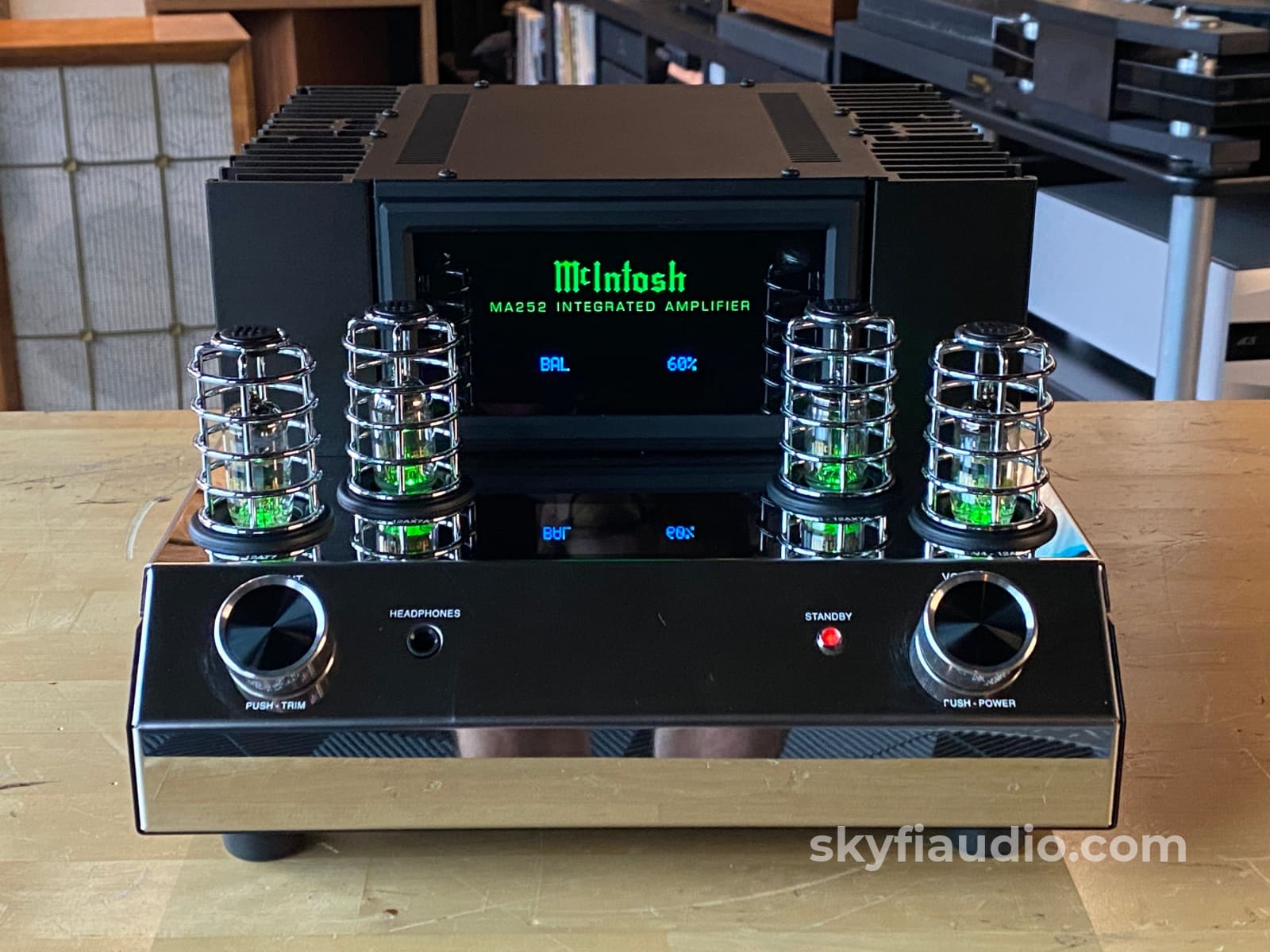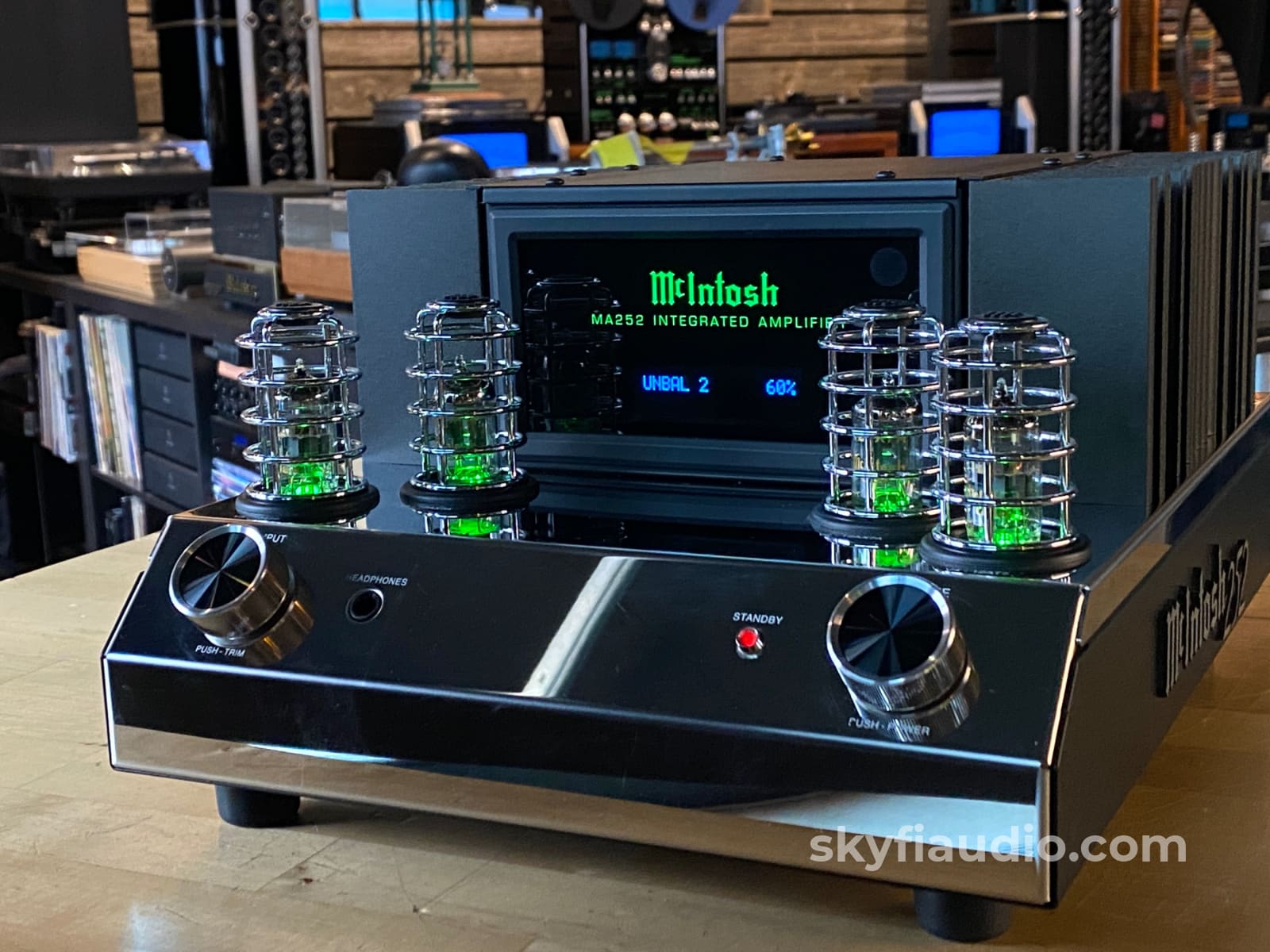











MCINTOSH MA252 HYBRID DRIVE INTEGRATED AMPLIFIER - Pre-Owned - Local Pickup Only
Click here to schedule an appointment to visit our store.
Please note this item must be purchased in store and we will not ship under any circumstances. Click here for more information about this policy.
Please support your local McIntosh Dealer.
General:
Pre-owned and well cared MA252. These are hard to find as most owners will hold on to them. Make out appointment to inquire about this item.
In very nice condition, working perfectly and showing slight signs of use.
Standout Features:
• Includes our Hybrid Drive™ technology that uses the best of vacuum tubes and solid state to produce the best sound performance
• Vacuum tube preamplifier and solid state power amplifier
• 100 Watts into 8 Ohms
• 160 Watts into 4 Ohms
Cosmetic Notes:
- Light swirling marks on flat and tilted chrome section of chssis
- Power on silk screen worn
- Remote shows use
- Great paint work throughout
- Display is bright and clear
Service Notes:
- A fresh set of McIntosh screened 12AT7 and 12AX7 tubes have been installed
- Updated to the latest available McIntosh firmware v1.04
Brand Background:
McIntosh Laboratory is an American manufacturer of handcrafted high-end audio equipment based in Binghamton, New York. The company was founded in 1949 by Frank McIntosh. The company designs and produces audio amplifiers, stereo tuners and other consumer electronics products.
Ownership:
Single Owner
Amplifier Recommendations:
N/A
Connections:
RCA and XLR Inputs, 5 way Speaker Binding Posts, Removable IEC Power Cord
General Sound:
Neutral sound with little to no coloration
Cosmetic Condition:
7/10 = Good. One or two minor scratches. Well Maintained.. See our detailed rating description here.
Working Condition:
Working perfectly and tested in our lab and listening room.
Included:
Unit, remote, manual and power cord.
Packing:
Original Manufacturers Packing
Reviews:
Click Here
Original MSRP:
$4,500.00
Specs:
ELECTRONIC SPECIFICATIONS
Power Output per Channel
100 Watts into 8 Ohms
160 Watts into 4 Ohms
Number of Channels
2
Speaker Impedance
4 or 8 Ohms
Rated Power Band
20Hz to 20kHz
Total Harmonic Distortion
0.03%
Dynamic Headroom
1.8dB
Frequency Response +0,-0.5dB
20Hz to 20kHz
Frequency Response, +0, -3dB
10Hz to 100kHz
Sensitivity Phono (Moving Coil)
N/A
Sensitivity Phono (Moving Magnet)
3.0mV
Sensitivity High Level (Balanced / Unbalanced)
0.6V/0.3V
Sensitivity (Power Amp input)
N/A
Signal To Noise Ratio (Moving Coil)
N/A
Signal To Noise Ratio (Moving Magnet)
80dB
Signal To Noise Ratio (High Level)
97dB
Signal To Noise Ratio (Power Amp input)
N/A
Input Impedance (Balanced / Unbalanced)
20K/20K
Damping Factor
8 Ohms: >200
4 Ohms: >100
Maximum Output (Balanced / Unbalanced)
8V Unbalanced
DIGITAL AUDIO SPECIFICATIONS
Digital-to-Analog Converter (DAC) Type
N/A
Digital Coaxial Input Sample Rate
N/A
Digital Optical Input Sample Rate
N/A
Digital MCT Input Sample Rate
N/A
Digital USB Input Sample Rate
N/A
GENERAL SPECIFICATIONS
Vacuum Tube or Solid State
Preamplifier: Vacuum Tube
Power Amplifier: Solid State
Output Type
Direct Coupled
Output Meters
No
Dual Layer Chassis
Yes
Chassis Finish
Polished stainless steel
McIntosh Monogrammed Heatsinks™
Yes
Power Requirement
120V 50/60Hz, 3.7A
Standby Power Requirement
<0.5 Watts
Link to Manual:
Click Here
Testing Process:
We start with a visual inspection of all internal components to make sure that there are no signs of heat stress or damage. Capacitors are checked for telltale signs of predictive failure including bulging, shrunken wrappers, or physical leakage. We also inspect the PCBs for discoloration from resistors or transistors that may have been running hot. On vintage units we often spot check select capacitors for value and ESR.
If the device has the ability to decouple the preamplifier from the power amplifier, we remove the jumpers and independently test each section. If the device cannot be decoupled, we assess the electronic condition of the piece by analyzing the speaker level output only.
We start by connecting the “preout” jacks of the integrated to a Sencore PA81 Power Analyzer which simulates real world loading conditions and gives us an oscilloscope interface. The first order of business is checking that the volume control works smoothly throughout its entire range with acceptable channel balance. This is accomplished by feeding a 1KHz sine wave into one of the preamp’s line level inputs while monitoring the preamp’s output on an oscilloscope. We then switch to a 1KHz square wave to test the tone controls, loudness function, and filters where applicable. During this step we are watching for equal alteration of the test signal by both channels. This also helps us identify dirty controls that will need treatment. Once the basic line stage functions are verified, we test each input individually. This is especially important for devices that use relays to select their sources. If the preamp section is equipped with a phono stage we test that as well. We use an inverse RIAA filter which allows us to feed a reference test signal into the phono input with the proper RIAA equalization and level. A square wave or sine sweep is used to verify that the device’s phono stage is faithfully reproducing the RIAA curve.
Next, we test the power amplifier section by connecting the integrated’s speaker outputs to a Sencore PA81 Power Analyzer which acts as a dummy load, DC offset monitor, and oscilloscope interface. We start with a low level 1KHz test signal at the “main in” jacks and slowly increase its amplitude while monitoring the output on an oscilloscope for signs of noise, clipping, distortion, or improper channel balance. We continue increasing the signal level until the amplifier reaches clipping. At this point we take an output power measurement and compare it to the spec sheet of the amplifier to verify proper performance.We finish off the bench evaluation with a 1KHz square wave check and a 20Hz to 20KHz sine sweep to assess the amplifier’s frequency response characteristics. This battery of tests will usually reveal if the amplifier has any issues that need further attention.
If the preamp and power amp both pass these tests, we reconnect the sections and verify that the preamp section can drive the power amp to rated power with a 1KHz tone on one of the line level inputs.
Before the device leaves the bench, we perform a listening test with actual music using a variety of preferred test tracks. Our benches are outfitted with familiar monitor speakers which help us identify inconsistencies that will not always show up on our test gear. The main things that we are listening for are hum or noise with no signal present, proper center image, clicks, pops, or any other obvious undesirable audio characteristics.
If the unit passes all of these tests it is moved to our long term testing rig where we simulate real word operating conditions for 6-8 hours. This allows us to monitor the unit for signs of thermal runaway or intermittent issues that only crop up when the unit has fully come up to temperature.
Choose options












